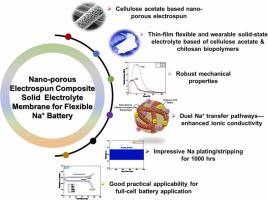当前位置:
X-MOL 学术
›
Nano Energy
›
论文详情
Our official English website, www.x-mol.net, welcomes your
feedback! (Note: you will need to create a separate account there.)
Composite scaffold of electrospun nano-porous cellulose acetate membrane casted with chitosan for flexible solid-state sodium-ion batteries
Nano Energy ( IF 16.8 ) Pub Date : 2024-07-05 , DOI: 10.1016/j.nanoen.2024.109971 Md. Mehadi Hassan , Xiao-Yan Wang , Afshana Afroj Bristi , Ruijie Yang , Xia Li , Qingye Lu
Nano Energy ( IF 16.8 ) Pub Date : 2024-07-05 , DOI: 10.1016/j.nanoen.2024.109971 Md. Mehadi Hassan , Xiao-Yan Wang , Afshana Afroj Bristi , Ruijie Yang , Xia Li , Qingye Lu

|
Emerging as a safe and economically viable alternative to lithium-ion batteries, the solid-state sodium ion battery (ss-SIB) has captured increasing attention as a transformative technology for realizing a decarbonized economy and ensuring a sustainable energy supply. Here we report a nanoarchitecture strategy of biodegradable, biocompatible, and naturally abundant cellulose derivative (cellulose acetate, CA) and chitosan (CH) biopolymer-based nano-porous electrospun composite electrolyte (ECE) for flexible and wearable ss-SIBs. A simple combination of electrospinning and solution casting was utilized to fabricate mechanically robust (13.76 MPa), thin-film (0.067 mm), and highly flexible ECE. The ionic conductivity of ECE was enhanced through optimization, taking into account the amount of sodium salt (NaPF6 ). The resulting ECE exhibited a sodium-ion conductivity of 1.04 ×10−4 S·cm− 1 and a sodium ion transference number of 0.48 at room temperature (RT=23 °C). The obtained Na+ transference number of 0.48 and a low activation energy (Ea = 0.13 eV) indicate the easy charge carrier diffusion ability of as-prepared ECE. The electrochemical stability window (ESW = 4.04 V) of ECE is studied by the linear sweep voltammetry (LSV) with the assembly of stainless steel and sodium metal electrodes. Without any interfacial modification, a uniform, stable, and long-time room temperature (RT) galvanostatic Na plating-stripping was observed for 1000 hrs at 0.5 mA·cm−2 current density in a symmetric (Na|ECE|Na) cell, this underscores impressive electrochemical stability and compatibility of ECE with sodium metal. Utilizing Na3 V2 (PO4 )3 (NVP) as cathode, fabricated ECE, and Na metal as anode in a hybrid full cell, a notable RT specific discharge capacity of 98.1 mA·h·g−1 was attained at a rate of 0.1 C with a capacity retention of 93.4 % over 120 charge-discharge cycles. This highlights the practical applicability of the nanostructured electrospun composite electrolyte for flexible and wearable ss-SIBs.
中文翻译:

壳聚糖电纺纳米多孔醋酸纤维素膜复合支架用于柔性固态钠离子电池
固态钠离子电池(ss-SIB)作为锂离子电池的安全且经济可行的替代品而兴起,作为实现脱碳经济和确保可持续能源供应的变革性技术,越来越受到人们的关注。在这里,我们报告了一种可生物降解、生物相容且天然丰富的纤维素衍生物(醋酸纤维素,CA)和壳聚糖(CH)生物聚合物基纳米多孔电纺复合电解质(ECE)的纳米结构策略,用于柔性和可穿戴的ss-SIB。利用静电纺丝和溶液浇铸的简单组合来制造机械坚固(13.76 MPa)、薄膜(0.067 mm)和高度柔性的 ECE。考虑到钠盐 (NaPF6) 的量,通过优化提高了 ECE 的离子电导率。所得ECE在室温(RT=23℃)下表现出1.04×10−4 S·cm−1的钠离子电导率和0.48的钠离子迁移数。获得的 Na+ 迁移数为 0.48 和低活化能 (Ea = 0.13 eV) 表明所制备的 ECE 具有易于载流子扩散的能力。通过组装不锈钢和钠金属电极的线性扫描伏安法 (LSV) 研究了 ECE 的电化学稳定性窗口 (ESW = 4.04 V)。在没有任何界面修饰的情况下,在对称 (Na|ECE|Na) 电池中,在 0.5 mA·cm−2 电流密度下观察到 1000 小时的均匀、稳定和长时间的室温 (RT) 恒电流 Na 镀层剥离,这凸显了 ECE 与钠金属令人印象深刻的电化学稳定性和兼容性。利用Na3V2(PO4)3 (NVP)作为阴极,制备ECE,并在混合全电池中使用Na金属作为阳极,显着的RT比放电容量为98。在0.1 C的倍率下达到1 mA·h·g−1,120次充放电循环后容量保持率为93.4%。这凸显了纳米结构电纺复合电解质对于柔性和可穿戴 ss-SIB 的实际适用性。
更新日期:2024-07-05
中文翻译:

壳聚糖电纺纳米多孔醋酸纤维素膜复合支架用于柔性固态钠离子电池
固态钠离子电池(ss-SIB)作为锂离子电池的安全且经济可行的替代品而兴起,作为实现脱碳经济和确保可持续能源供应的变革性技术,越来越受到人们的关注。在这里,我们报告了一种可生物降解、生物相容且天然丰富的纤维素衍生物(醋酸纤维素,CA)和壳聚糖(CH)生物聚合物基纳米多孔电纺复合电解质(ECE)的纳米结构策略,用于柔性和可穿戴的ss-SIB。利用静电纺丝和溶液浇铸的简单组合来制造机械坚固(13.76 MPa)、薄膜(0.067 mm)和高度柔性的 ECE。考虑到钠盐 (NaPF6) 的量,通过优化提高了 ECE 的离子电导率。所得ECE在室温(RT=23℃)下表现出1.04×10−4 S·cm−1的钠离子电导率和0.48的钠离子迁移数。获得的 Na+ 迁移数为 0.48 和低活化能 (Ea = 0.13 eV) 表明所制备的 ECE 具有易于载流子扩散的能力。通过组装不锈钢和钠金属电极的线性扫描伏安法 (LSV) 研究了 ECE 的电化学稳定性窗口 (ESW = 4.04 V)。在没有任何界面修饰的情况下,在对称 (Na|ECE|Na) 电池中,在 0.5 mA·cm−2 电流密度下观察到 1000 小时的均匀、稳定和长时间的室温 (RT) 恒电流 Na 镀层剥离,这凸显了 ECE 与钠金属令人印象深刻的电化学稳定性和兼容性。利用Na3V2(PO4)3 (NVP)作为阴极,制备ECE,并在混合全电池中使用Na金属作为阳极,显着的RT比放电容量为98。在0.1 C的倍率下达到1 mA·h·g−1,120次充放电循环后容量保持率为93.4%。这凸显了纳米结构电纺复合电解质对于柔性和可穿戴 ss-SIB 的实际适用性。











































 京公网安备 11010802027423号
京公网安备 11010802027423号